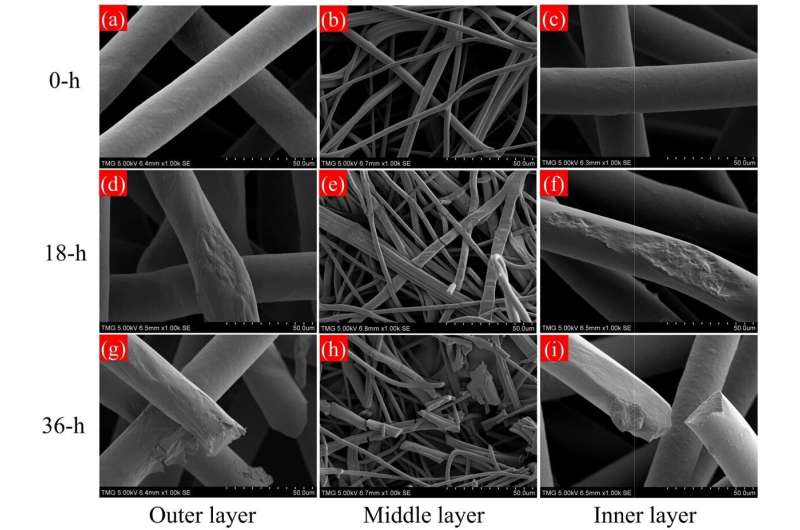More microplastics are entering the ocean from disposable masks

The enormous surge of face-mask use since the beginning of the global lockdown in March 2020 has saved countless human lives, a crucial component to limiting the transmission of the novel coronavirus. But with 129 billion masks being consumed globally every month, disposal has become a major issue with implications on human, animal and ecological health.
The problem becomes more acute as, according to a recent study by Concordia researchers, a single mask left exposed under natural conditions can release more than 1.5 million microplastics into the aqueous environment. In a new paper, Ph.D. student Zheng Wang and Chunjiang An, an assistant professor in the Department of Building, Civil and Environmental Engineering, investigate how disposable masks break down in a shoreline environment and the environmental implications that poses. They examine changes in chemical composition and strength degradation of the three different mask layers caused by UV exposure and sand abrasion.
Shorelines, they write, are not only the main receptors of discarded masks; their unique environment also leads to further breakdown of masks into plastic particles.
The study was published in the Journal of Hazardous Materials.
36 hours to break down
The researchers simulated shoreline environment conditions on a set of masks and created a control group with which to compare. The experimental masks were placed in an uncovered Petri dish and exposed to UV lights between one and 48 hours. Control samples were wrapped in aluminum foil and exposed under the same conditions.
They then separated the masks by layer—outer, middle and inner—and irradiation times, and placed them in flasks to test and control for the presence of sand. The strips were then analyzed using a scanning electron microscope and an atomic force microscope. The researchers also examined particle size distribution in a water sample using a LISST-200X particle size analyser.
After 18 hours of weathering, the outer and inner layer of the masks exhibited noticeable damage to their fiber surfaces. Damage to the fibers in the middle layer, however, which are six times smaller than those in the outer and inner layers, was more severe: the surfaces had become abrasive, and fracturing had occurred. After 36 hours of exposure to UV rays, fibers in all three layers had fractured, creating miniscule fiber fragments, and particles started attaching themselves to the fibers. Their surfaces showed obvious signs of weathering, including cracks, flakes, grooves and pits. Damage was most severe in the middle layer, where all the fibers had broken into small fragments.
These findings coincided with an observed increase in the number of microparticles released into the water after 18 hours of weathering. After 36 hours, the researchers observed the broken mask fibers easily entering the water, even to the naked eye, and millions of small particles existed in the sample water.
Local solutions possible
The results tell Wang and An that urgent action is needed to securely dispose of the billions of masks being used worldwide every month.
“We need to increase our environmental awareness and reduce abandoned masks in the environment. Our governments and industries also need to improve the existing waste management practices and manufacture masks with less environmental impact,” Wang says.
On an immediate, practical level, An adds, simply adding more dedicated mask bins for public use on places like university campuses would help the collection of used masks and prevent abandoned masks from entering the natural environment.
Face masks are a ticking plastic timebomb
Zheng Wang et al, Disposable masks release microplastics to the aqueous environment with exacerbation by natural weathering, Journal of Hazardous Materials (2021). doi.org/10.1016/j.jhazmat.2021.126036
Citation:
More microplastics are entering the ocean from disposable masks (2021, October 6)
retrieved 6 October 2021
from https://phys.org/news/2021-10-microplastics-ocean-disposable-masks.html
This document is subject to copyright. Apart from any fair dealing for the purpose of private study or research, no
part may be reproduced without the written permission. The content is provided for information purposes only.
For all the latest Science News Click Here
For the latest news and updates, follow us on Google News.

